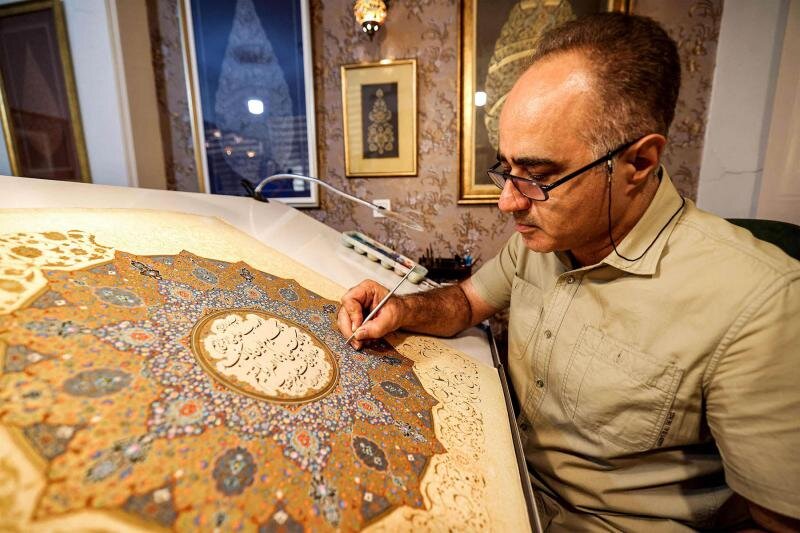Tazhib: an ancient yet reviving illumination art

TEHRAN - In an age dominated by AI-assisted graphic design, the ancient Persian art of Tazhib offers a compelling counterbalance, emphasizing patience, precision, and a deep connection to tradition.
There are hundreds of Iranians across the country and beyond that keep the ancient art alive. One of those, Mohammad-Hossein Aghamiri, in a recent interview with AFP, has said he sometimes dedicates up to six months to a single design, knowing that one misplaced stroke can mar the entire piece.
Aghamiri's meticulous approach involves using fine brushes to apply natural pigments onto paper, creating intricate floral patterns, religious motifs, and elegant calligraphy. This art form, which has adorned literary manuscripts, religious texts, and royal edicts for centuries, is known for its non-figurative and geometric flourishes that traditionally decorate the margins of holy books and epic poems.
Aghamiri, 51, is one of the remaining dozen masters of Tazhib in Iran, a craft that was inscribed on UNESCO’s list of intangible cultural heritage last year. With over 30 years of experience, he highlights the unique demands of Tazhib, describing it as a practice requiring immense patience and precision. “It’s not accessible to everyone,” he says, speaking from his studio in downtown Tehran.
The art of Tazhib dates back to the Sassanid era in pre-Islamic Iran but flourished after the seventh-century advent of Islam, which banned human depictions. This historical backdrop underscores the cultural and religious significance of Tazhib, which has evolved while maintaining its core aesthetic principles.
When a reporter visited Aghamiri, he was immersed in creating a shamsa design, a symbolic representation of the sun, about 50 centimeters across. This design, featuring intertwined abstract, geometric, and floral patterns, had been a work in progress for over four months, with Aghamiri aiming to complete it within six weeks. He uses natural pigments such as lapis lazuli, saffron, gouache, and pure gold imported from China. "Gold has a very strong visual appeal," Aghamiri explains. "It’s expensive and it enhances the perceived value of the work."
Coming from a family with a rich history in Iranian craft traditions, including calligraphy, miniature painting, and carpet design, Aghamiri's work has been showcased in museums across Iran and the Persian Gulf region. The demand for his art extends beyond Iran, with 80 percent of his works being sold in countries like the UAE, Qatar, and Turkey.
In recent years, Aghamiri has also attracted international interest, teaching Tazhib online to students worldwide, particularly in the United States. He hopes to hold workshops in Britain soon, emphasizing that Persian illumination fundamentally differs from European illumination art, which flourished in the Middle Ages. Unlike the more figurative European designs that depict human faces, animals, and landscapes, Persian Tazhib focuses on abstract and geometric patterns.
The recognition of Tazhib by UNESCO in December 2023, requested by Iran, Turkey, Azerbaijan, and Uzbekistan, marks a significant milestone for this ancient art form. This acknowledgment has rekindled interest and hope for its future. “Twenty years ago, I didn’t have much hope for the future of Persian illumination,” Aghamiri admits. “But things have changed, and I see that this art is becoming more and more popular.”
Tazhib, an intricate form of Islamic illumination, involves decorating manuscripts, book covers, Qur'ans, and various surfaces with elaborate designs using gold, vibrant colors, and delicate patterns. While the term strictly refers to manuscripts decorated with gold or silver, it broadly encompasses any decorated or illustrated manuscript. Islamic manuscripts, therefore, are often referred to as illuminated, illustrated, or painted works.
The resurgence of Tazhib in the digital age highlights a yearning for the tactile, slow, and deliberate processes of traditional craftsmanship. As Aghamiri and other masters continue to preserve and teach this art, they ensure that the legacy of Persian illumination remains vibrant and relevant, bridging the past with the present and inspiring future generations to appreciate and carry forward this exquisite cultural heritage.
In a world where speed and efficiency often overshadow artistry and tradition, the art of Tazhib stands as a testament to the enduring value of meticulous craftsmanship and cultural continuity. Through the dedicated efforts of artists like Aghamiri, this ancient practice continues to illuminate not just manuscripts but also the rich cultural tapestry of Iran and the broader Islamic world.
AM
Leave a Comment